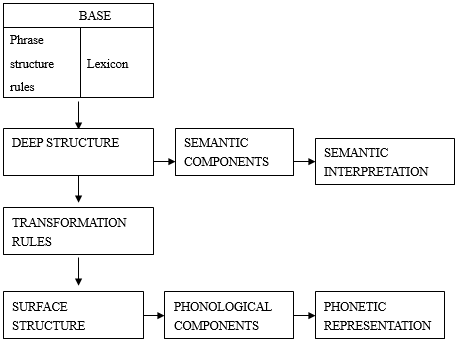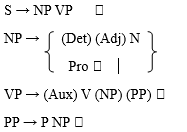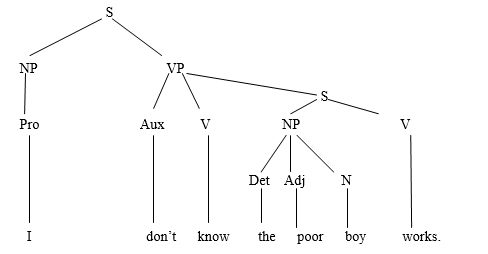Chapter 1
 5.4 Transformational-generative (TG) grammar
5.4 Transformational-generative (TG) grammar
I.Brainstorming
Have heard about Chomsky? Do you know anything about him?
II. Transformational-generative (TG) grammar
1.The goal of TG grammar
Goals
Chomsky (1957) – grammar is the knowledge of native speakers.
A scientific grammar should be observationally, descriptively and explanatorily adequate.
TG grammar must account for all and only grammatical sentences. TG grammar accounts for the mental process of our speaking.
Writing a TG grammar means working out two sets of rules – phrase structure rules and transformation rules – which are followed by speakers of the language.
A theoretical model to account for the mental process of speaking

2.Syntactic categories: is a class of expressions that substitute for one another without loss of grammaticality.
Sentence (S) Adjective (Adj)
Noun Phrase (NP) Pronoun (Pro)
Verb Phrase (VP) Auxiliary Verb (Aux)
Prepositional Phrase (PP) Verb (V)
Determiner (Det) Adverb (Adv)
3.Phrase structure (PS) rules: are rules that specify the constituents of syntactic categories. Those rules are part of speaker’s syntactic knowledge.

The four rules generalized above various aspects of syntactic knowledge. The syntactic categories on the light of the arrow are the immediate constituents of the category on the left. The constituents within brackets are optional. The constituents within brace brackets are alternatives.
4.Tree diagrams
Definition:
A tree diagram is a formal presentation of sentence structure with syntactic categories provided (it is also referred to as a phrase maker or a constituent structure tree). A tree diagram without syntactic categories fails to reveal ambiguous structure in some cases.
Functions:
These up-side-down “trees” disclose three aspects of speakers’ syntactic knowledge
1) The linear structure of the sentence;
2) The hierarchical structure of the sentence;
3) The lexical category of each word
The relationship between tree diagrams and phrase structure rules
In GT grammar, tree diagrams and phrase structure rules are closely related. Tree diagrams correspond to phrase structure rules in specifying syntactic categories. The categories that occur to the left of the arrow in a phrase structure rule are phrasal categories. They do not appear at the bottom of the tree. They label the node point or branching of the tree. The categories that never occur on the left side of the arrow are lexical categories, which are labels of class of words right above the words at the bottom of the tree.
5. Recursion and the infinitude of language
S contains NP and VP and that S may be a constituent of NP and VP. NP and PP can be mutually inclusive. If phrasal categories appear on both sides of the arrow in phrase structure rules, the rules are recursive. Recursive rules can be applied again and again, and the phrase structure can grow endlessly.

6.Sub-categorization of the lexicon.
The process of putting words of the same lexical category into smaller classes according to their syntactic characteristics is called sub-categorization. •
7.Transformational rules (T-rules)
Particle movement T-rule
E.g. John turned the machine off.
John turned off the machine.
Reflexivization T-rule
E.g. I wash me (myself).
Deletion T-rule
E.g. (You) help yourself to the cake.
Replacement T-rule
E.g. John beat Tom. He beat Tom.
The house needs repairing (to be repaired).
Copying T-rule
E.g. He is coming, isn’t he?
He has finished his homework, hasn’t he?
Insertion T-rule
E.g. A fish is swimming in the pond.
There is a fish swimming in the pond.
III. Conclusion
Transformational generative grammar is a theoretical grammar (not a pedagogic grammar) which attempts to account for this aspect of apeakers’ knowledge of sentence construction. It is therefore psychological in nature, as made by Chomsky (1965).
